A quarter of the way through the season, the San Jose Sharks continue to do a lot right, despite a recent rough 0-2-1 run. Back-to-back regulation losses to the Florida Panthers and Boston Bruins were followed by a shootout loss to the rival Anaheim Ducks. The brief skid was broken with a 3-1 win over the Arizona Coyotes.
The 2-0 loss to the Panthers was perhaps the most frustrating loss of the season. Aside from being defeated by a team in the Atlantic Division cellar, two Sharks goals were overturned upon review (one close but clearly correct, the other more controversial). The loss to the Bruins also featured two reviewed goals, with equally frustrating results. The Sharks’ score was overturned while the Bruins’ goal counted, critical plays in a 3-1 loss.
Despite the overturned goals, the shootout loss to the Ducks and the fact that the Sharks solidly won the shot counter in each game, the news isn’t all bad. In all three games, the Sharks dominated the third period at times, outshooting their opponent 49-21, but were outscored 2-1. Hockey happens.
Sharks Depth Bodes Well
Also on the plus side, the Sharks have been able to look at a large number of players early in the season. Paul Martin’s injury opened the door for a pair of impressive defensemen, Joakim Ryan and Tim Heed. Barclay Goodrow earned playing time and has been effective. An injury to Goodrow opened up a spot and Danny O’Regan is making the most of his opportunity.
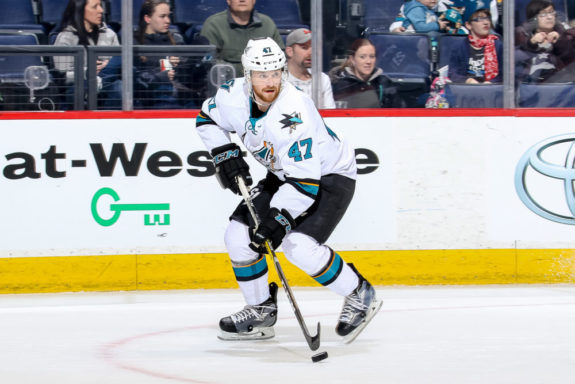
Players with limited NHL experience are getting a chance to earn a spot and Sharks head coach Peter DeBoer is getting a good look at his extended roster. San Jose has used 23 skaters, eight defensemen and 15 forwards.
While nine forwards are regulars, the remaining six are battling for starting spots. Four are younger players (O’Regan, Goodrow, Kevin Labanc and Ryan Carpenter). Two veterans (Jannik Hansen and Joel Ward) are also in the mix. In the short run, this can lead to inconsistency but over the course of a season, this is good news. The Sharks’ depth means the team can hold up better over the season, deal better with injuries and have assets which can be traded if something worthwhile comes up.
At the quarter mark, the Sharks are 11-8-1. This projects to 94 points, which is on the bubble for a playoff spot.
DeBoer’s Cautious Course Changes
The Sharks can not compromise what is working. What is working well is their defense and goaltending. In almost every metric, the Sharks are among the league-leaders in these areas: shot suppression, save percentage, penalty killing and so forth.
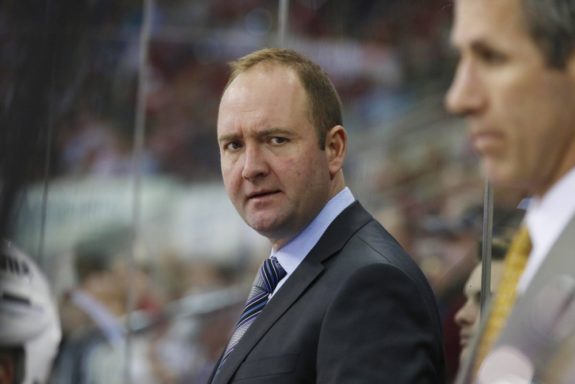
However, they are not good at putting the puck in the opponent’s net. During the first 58 minutes of play in the last eight games, the Sharks have only ten goals and never more than two in a game prior to the closing two minutes.
Change needs to occur, but DeBoer is right to exercise caution.
Pavelski & Thornton
Recently, DeBoer experimented with separating Joe Thornton and Joe Pavelski. The experiment lasted less than a full game. The pair, commonly called “the Joes”, have skated on the same line together since the Todd McLellan era.
In the 2015-16 season, when the Sharks skated to the Stanley Cup Final, the pairing made sense. Each Joe finished the season with a plus-25 rating and the Sharks scored twice as often as their opponents with the Joes on the ice. The line, most often with Tomas Hertl on the wing, dominated.

In 2015-16, there were compelling reasons to have them together. In 2017-18, there is no compelling reason to keep them together. At even strength, Thornton has two goals, five assists and is minus-4 while Pavelski has four goals, four assists and is minus-3. They are different players than they were two seasons ago. Breaking up the Joes will create a headline, but it is neither urgent nor a big change.
Brent Burns
The season has been a disappointing one for the reigning Norris Trophy winner and owner of the largest contract in team history. No goals, seven assists and a minus-6 rating indicate that he’s struggling to find his game. Brent Burns has spent most of the season without last year’s partner, Paul Martin. However, Joakim Ryan has looked solid opposite Burns and might be a better player than Martin.
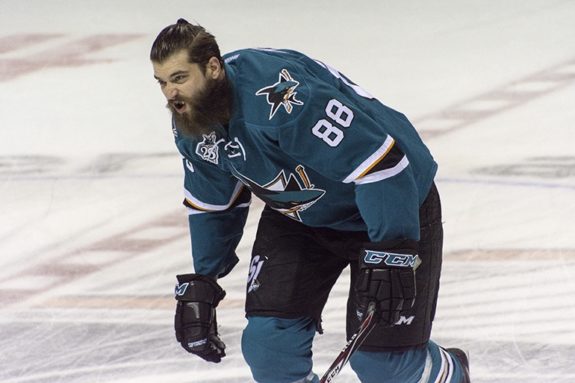
Burns’ play is an example of cautious change. He is doing plenty right, but the goals and assists are not coming. Defensively, he’s been more problematic. In the 3-1 loss to the Bruins, Burns was implicated on all three Boston tallies.
In the following game against Anaheim was better. He helped force a turnover that led to one of the Sharks goals and played well defensively, including on an odd-man rush where he did an excellent job of taking away the passing lane.
Last season, Burns used a lethal wrist shot from the point to create an enormous amount of offense. This season, teams have done a good job challenging his shot. But as players come out to the point to slow Burns down, it opens up space in the slot areas and closer to the crease. Right now, neither Burns’ point shot nor the forwards down low are doing much scoring. One gets the feeling that once one thing starts working, the others will too, and opponents will be forced to pick their poison.
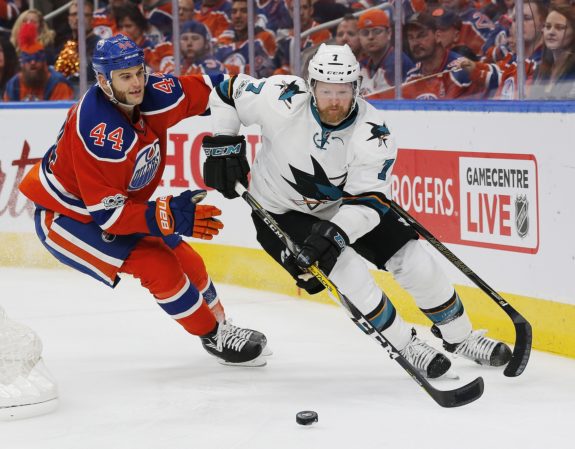
Burns is capable of playing more consistently, especially on defense. It isn’t clear where the problem lies, but we’ve seen him play better at both ends of the ice. If Burns can return to form, this alone dramatically improves the Sharks.
Sharks Problematic Power Play
This is one of the Sharks’ biggest problems. DeBoer did major surgery on the two units before the Anaheim game and well, the results were better. Both units were dangerous and they got a goal from Joonas Donskoi. It was the team’s first power play goal since Nov. 1.
In particular, the top unit featured Logan Couture, Tomas Hertl and Donskoi. This is also the Sharks’ top line during 5-on-5 play (Melker Karlsson is often on the wing instead of Donskoi but he is injured). Using the same forward group for both even strength play and the power play has benefits though it’s too early to call it a success. Against Arizona, the Sharks failed to get a shot on goal on their lone power play and gave one up.
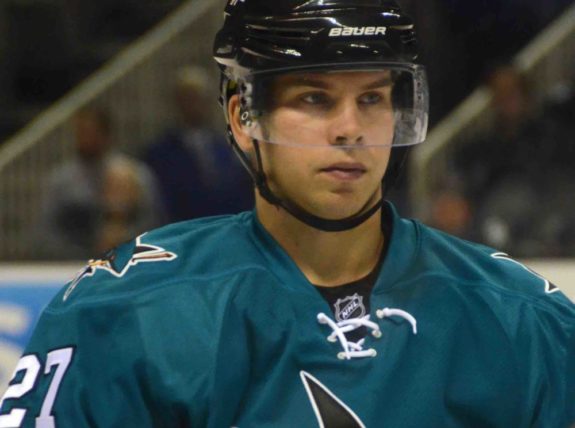
Nothing Radical Needed in San Jose
The Sharks are succeeding but they are not among the top-tier teams. There is no need for a major overhaul (unless we’re talking a trade for an elite center, which is unlikely), but some adjustments and improvements are due. Importantly, adjustments cannot compromise their core identity as a team that doesn’t give up much to their opponents.
In the month of November, Sharks goaltenders have a .936 combined save percentage. In the last thirteen games, the Sharks have allowed two or fewer goals eleven times. They are competitive in almost every game.
The revamped power play illustrates how a simple idea can work. Take the players who are playing effectively as a unit and put them on the power play together. This is not a radical change, it’s actually quite cautious. Cautious change is what San Jose needs now.
Zeke’s Notes
• In the nine-round shootout against Anaheim, Martin Jones allowed a career-worst four goals. Jones has been exceptional in shootouts over his career. Burns had one of the Sharks tallies in the shootout. While it doesn’t count as a goal in the stat column, it does mark the first time he put a puck past a goalie this season.
• The Sharks’ health is a creeping issue. Neither Joe appears fully healthy, something indirectly confirmed by the team. Goodrow tangled with Mark Pysyk, and the Florida defender landed on Goodrow as they fell to the ice. Pysyk’s stick, backed by his full body weight, cross-checked Goodrow’s ribs. Goodrow has not played since. Karlsson missed the last two games. Meanwhile, Martin, who seemed close to a return from his ankle problem, suffered a setback and will not be available in the near future.